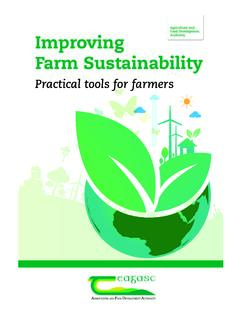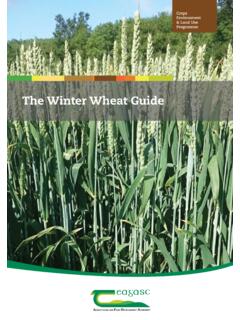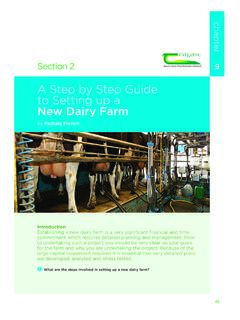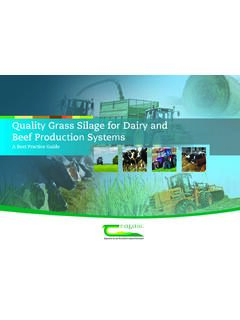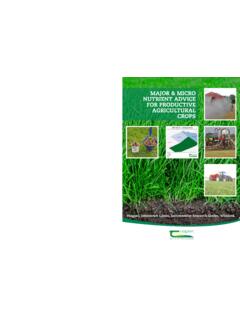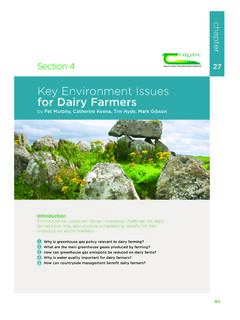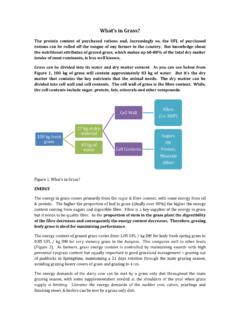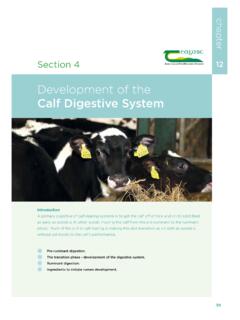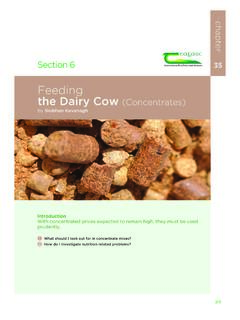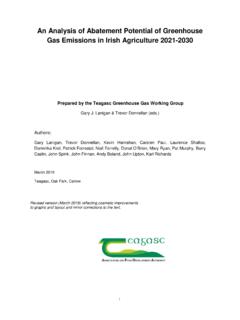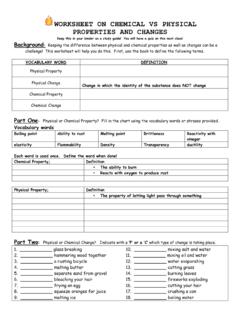Transcription of Growing POTATO Fact Sheet - Teagasc
1 11 POTATO fact sheetGrowing POTATO fact Sheet Crops Environment & Land Use Programme23 POTATO fact sheetGrowing POTATO fact sheetHigh yields of good quality potatoes can be produced under Irish soils and climatic conditions if the crop is well managed throughout the Growing season. The crop must also be carefully handled after harvest to maintain quality. POTATO growers need to pay particular attention to site and crop rotation, seedbed preparation, disease control and a suitable field, soil-type and place in the crop rotation is an important first step to producing potatoes can be grown across a wide range of soil types and should not be grown more than one year in four in a rotation, otherwise POTATO cyst eelworm may cause a cultivations to produce a clod free seed bed are required. Potatoes can be divided into three categories based on when they mature.
2 Earlies normally mature in about three and a half months - 100 days or so. The second earlies will take about four months - 120 days or so. Maincrop potatoes can take between four and five months to fully mature. First earlies are normally sown in early February in Wexford and late February in the Northeast. Second earlies are sown from early to mid March and maincrop are sown from mid March (mainly April) to early May. See more on page of the above depends on maincrop potatoes in April, when soil temperatures rise above 7oc. Plant about 10 cm deep and in general 20-25 cm apart(in 80 cm drills). See more on page need significant amounts of N, P, and K nutrients and in some cases additional trace elements. Use the result of a recent soil test to decide the rate of fertiliser application. See more on page must be protected against competition from weeds.
3 Use a herbicide or combination of herbicides to keep weeds under control. In an organic situation stale seedbeds, manual hoeing or gas burning can be considered. See more on page and slugs can be a problem following grass crops. Aphids can spread virus diseases, and need to be controlled in crops from which seed is to be planted. Eelworm fields must be avoided for at least 10 years. See more on page is essential to prevent POTATO blight entering the crop. Use a mixture of cultural and chemical control methods to keep the disease at bay. Start the fungicide programme in time and don t miss any applications. See more on page fact sheetTable of Contents Production 4 Soil Preparation 7 Planting the Crop 8 Crop Nutrition 13 Weeds.
4 Pests and Diseases 15 Disease Control 19 Harvesting Potatoes 23 Question & Answer Section 2545 POTATO fact sheetProduction ProductionEach year consumers spend approximately 162 million on potatoes. Penetration of potatoes into Irish households is at 95% and can be referred to as our staple food. Fig 1 Main counties of Commercial POTATO ProductionSome FiguresThe information in this document is based on a combination of data from the Central Statistics Office (CSO), IFA and from the Department of Agriculture Fisheries and Food (DAFF). Figures for production area are based on CSO data, while percentages for individual POTATO varieties are based on surveys of growers. All figures relate to production by commercial POTATO growers, defined as those Growing hectares (2 acres) or more of potatoes.
5 Production AreaIreland s total production area in 2012 was over 8,700 hectares. Varieties GrownKey Varieties % of area grown in 2011: Rooster 56%; Kerrs Pink 10%; Queens 8%; Golden Wonder 3%; Records 2% and others 21%. Grower LocationKey POTATO Production Counties % of area planted by county: Meath 22%; Dublin 15%; Wexford 13%, Louth 12%; Donegal 10%; Cork 8% and others 20% 45 POTATO fact Sheet Agronomic requirementsSites and SoilsLocation Maincrop ware potatoes can be produced in most parts of the country. The term ware potatoes are those which are sold fresh for eating by consumers. Crops destined for processing are best located near the processing factory so that the crop can be quickly transported at a relatively low and soil typeAn ideal site is a slightly sloping, south-facing field with shelter from yields of potatoes can be achieved on a wide range of soil types.
6 Potatoes are also suited to acid soils, pH to is clay soils are suitable provided they are well drained and ploughed early. Light or shallow soils are prone to drought and yields of maincrop potatoes will be lower if a shortage of water occurs during the Growing season. Proximity of the site to a water course is also important, ensuring the crop can be irrigated. This allows the crop to pass for washed pre packs which command a higher premium for the fact sheetRotation A correct rotation is required to avoid the build-up of POTATO cyst eelworm, disease and volunteers. Potatoes should not be grown more often than one year in four, but in areas of intensive ware production a longer interval may be cyst nematode (eelworm) may persist in soil for 20-30 years. Volunteer potatoes, in addition to contributing to the eelworm problem are also a source of blight and virus disease, and should be controlled where possible in succeeding crops.
7 See section on pest control:- Pest Control67 POTATO fact sheetSoil PreparationQuick, even emergence and good early crop growth are essential in the quest for good yields of quality potatoes. Where grass is ploughed up it is recommended that the grass is burned off in advance of ploughing using Glyphosate. Deep cultivation (down to approximately 25 cm) is an essential start to seedbed preparation. The aim of subsequent cultivations is to provide a fine seedbed with 12 - 15 cm of clod free tilth. Loose cloddy seedbeds will dry out, causing slow growth, irregular emergence and low stem counts. Wait until soils are dry enough, and then use an appropriate implement for cultivation. Cultivating soils that are not dry often results in compaction, and damage to soil structure. This restricts the rooting capacity and subsequent yield of the POTATO ground is usually cultivated with a heavy tine cultivator prior to bed tilling and ridging.
8 Bed tilling and ridging involves cultivating the soil to a depth of 15 -18 cm, and leaving it in large ridges between 175 185 cm in firm fine seedbed is essential for planting Stone separation Stone separation is the process of removing stones and clods from the formed ridges, and burying them between alternate rows. This substantially reduces tuber damage during harvesting, and greatly increases harvester ridges should have been adequately cultivated prior to stone separation to ensure there are no excess clods to be removed. Soils need to be dry to ensure good separation whilst also avoiding damage to soil fact sheetPlanting the CropWhich VarietyConsumers prefer high dry matter varieties with red skin. Rooster is the most popular variety in Ireland the Rooster s release in 1991, the area under production has grown to over 55% of the total POTATO ware area in Ireland today.
9 The success of Rooster is due largely to its excellent taste and cooking quality, as well as its superior agronomic characteristics. There are a number of important factors to consider when selecting a POTATO variety for the ware include: Yield Eating quality Maturity Keeping quality Disease resistance Seed availabilityYield High yields are essential to enable producers to make a profit. Variety is a major determinant of quality Although quality preferences of consumers are changing most consumers prefer high dry matter potatoes and red skinned Choose varieties which mature in succession aim to have harvesting completed by the end of Quality Varieties differ in their suitability for prolonged storage. Varieties like Golden Wonder and Rooster store well. Kerr s Pink is difficult to Resistance Varieties differ in their resistance to disease.
10 Losses can be reduced or eliminated by being familiar with the disease resistance of the varieties being grown so that adequate control measures can be 1 Main Crop Varieties for the Home Ware MarketMaturityVarietiesEarly Main CropRecordLate main cropKerr s Pink, RoosterVery late main cropGolden Wonder89 POTATO fact sheetRecord is a yellow fleshed early main crop variety with moderate yields. It is subject to internal bruising if harvested in cold condition or handled unproperly. It is susceptible to foliage blight and virus yellow but is resistant to sprang. Good for chips and boilingKerr s Pink is a red skinned late main crop variety with deep eyes. It is a white fleshed, high dry matter, floury variety used for boiling, baking and home is susceptible to foliar and tuber blight and to common scab. Because of its poor keeping quality it is difficult to store.
